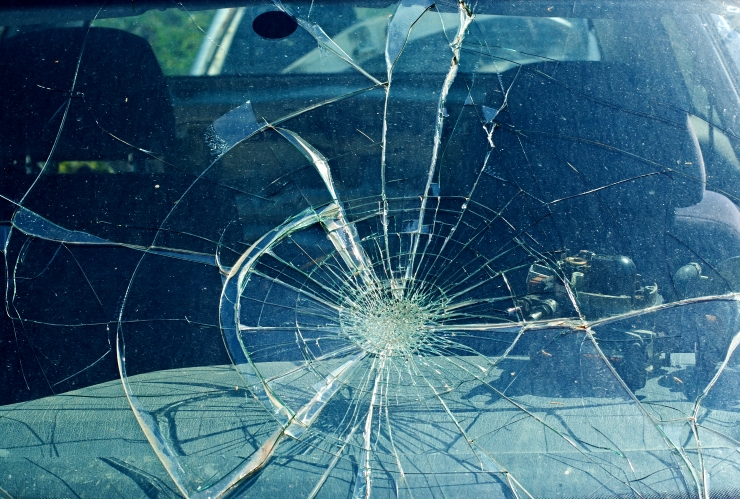You’re driving down the highway when, unexpectedly, the car in front of you kicks up a pebble. You’ve boarded up your windows and your family is safe, but strong winds have ripped down a branch over your driveway. Both scenarios strike unexpectedly, both cause damage to your windshield. Now what do you do?
Your car’s glass can break in any number of ways. The good news is that it’s often an easy fix if you have comprehensive coverage as part of your car insurance policy. If so, your insurance carrier will pay to repair your windshield or window for a covered glass loss, less your deductible. Depending on the state you live in, you may have full glass coverage (or the option to purchase it), which pays the full amount of a covered glass loss with no out-of pocket cost to you.
For the most part, filing a glass claim is pretty simple. Once you submit the claim to your carrier, they’ll start the process to repair your broken glass and get you back on the road quickly. However, you should be aware of a few important issues.
What Is an Assignment of Benefits? Is It Being Abused?
Please don’t sign anything before you read and understand what you’re signing. And never sign a blank document—paper or digital.
This seems like good advice, but many of us have probably ignored this from time to time. For example, have you ever clicked on an online checkbox certifying that you read the Terms and Agreements when, in fact, you didn’t? But consider that when a contractor or repairman says, “Just sign this. We’ll take care of things with the insurance company,” a red flag should go up.
These individuals may be encouraging those with glass damage to sign away the rights of the claims process through an Assignment of Benefits (AOB).
AOB is a long-established legal tool which allows a service provider to collect claim settlement funds directly from an insurance carrier–without having to directly involve the customer. It is intended to be used after the service provider completes emergency repair work.
However, glass damage is a relatively quick and low-cost repair, so signing an AOB isn’t necessary. If signed, you could lose control over the claims process, as well as the workmanship protections you may have through your policy. What’s worse, it could result in an inflated claim – which can drive up premiums for you and others.
Here’s an example of what could happen if you’re not careful.
- A repair shop representative points out that the glass on your windshield or windows is damaged; or after noticing you have glass damage, you reach out to a repair shop before calling your insurance company.
- They tell you that they can fix the damage – and that they’ll deal with the insurance company, so you don’t have to lift a finger. All you have to do is sign the paperwork and give them your insurance card or information. Before, during or after repairing or replacing your glass, they present you with AOB papers to sign.
- Sometime after making the repairs, they bill your insurance company, for several times the amount of what the repair costs.
- They don’t report the claim prior to completion of the work, which is required in your insurance contract.
- The insurance company denies the claim or pays what is allowed by your insurance contract, so the repair shop sues the insurance carrier. (Remember, they are acting on your behalf.)
- Now the issue is taken to the courts, and costs balloon to several thousand dollars in lawyer fees and more.
In this scenario, after signing the papers, your glass was fixed. But, those fixing your glass used this as an opportunity to do much more than just repair your vehicle. In some instances, the repair shop fails to file a claim. Then, they submit an invoice for much more than the cost to repair the glass damage– remember, glass damage is a relatively quick and low-cost repair.
And finally, they file a lawsuit on your behalf costing thousands of dollars in attorney fees. And because of their behavior, your rates and the rates of other policy holders in your area could go up.
How Should I Submit a Glass Claim?
The primary benefit offered by these repairmen – “We’ll handle all the paperwork with the insurance company” – is already a quick and painless process, as long as you take one simple step at the beginning:
Call your insurance company first.
With The Hartford, submitting a claim is as easy as calling 1-877-805-9918 or going online.
After you submit your claim, The Hartford will partner with you to resolve your glass claim as quickly as possible. We’ll put you in touch with windshield and window repair shops and will waive the deductible when the windshield or window can be repaired rather than replaced.
Although you can use any glass repair shop after reporting your claim, there are benefits to using The Hartford Auto Glass Repair Network, a group of more than 12,000 glass repair shops approved by The Hartford. Most of these shops have a mobile service that will come to you.
The Hartford will stand behind the workmanship of the repairs done by our network shops for as long as you own your car. We’ll also work directly with the glass repair shops, speeding up the process and minimizing the effort on your part. And since we pay network shops directly, you won’t pay out-of-pocket expenses (except for your deductible, if one applies).
What Should I Do If I Suspect Fraudulent Activity?
Every year, billions of dollars are lost to insurance fraud, which includes staged auto accidents and inflated medical bills. Fraud can occur with something as simple as a glass-only claim. If you’re a customer of The Hartford and suspect fraud, make sure the first thing you do is call The Hartford to report the claim and schedule the repair. Afterward, contact your Hartford Claims professional at 1-800-547-9276 and we’ll investigate the matter through our Special Investigations Unit.







Such an beneficial information, keep up the good work. Thank you so much for sharing.
I like that you pointed out how filing a car glass insurance claim is pretty simple for the most part. I was reading up about car insurance and I saw a small bit about car glass insurance. Glass is prone to brakeage so having an insurance for it sounds quite convenient.
I like your glass tips. I need to get a new windshield. My old one broke.
Informative post about auto glass repair claims
How do I purchase an auto glass (only) insurance from you?
Hi Andrew, thanks for reaching out. The Hartford doesn’t sell physical damage coverage on its own, you would have to purchase liability and comprehensive coverage as well. You can get a quote by visiting us here: https://www.thehartford.com/aarp/car-insurance
Glass repair is something that I don’t think I could ever do. That seems like something where everything has to be done correctly. If my windshield broke on the road in any way or kind of break, I would take it to a professional to get it fixed.